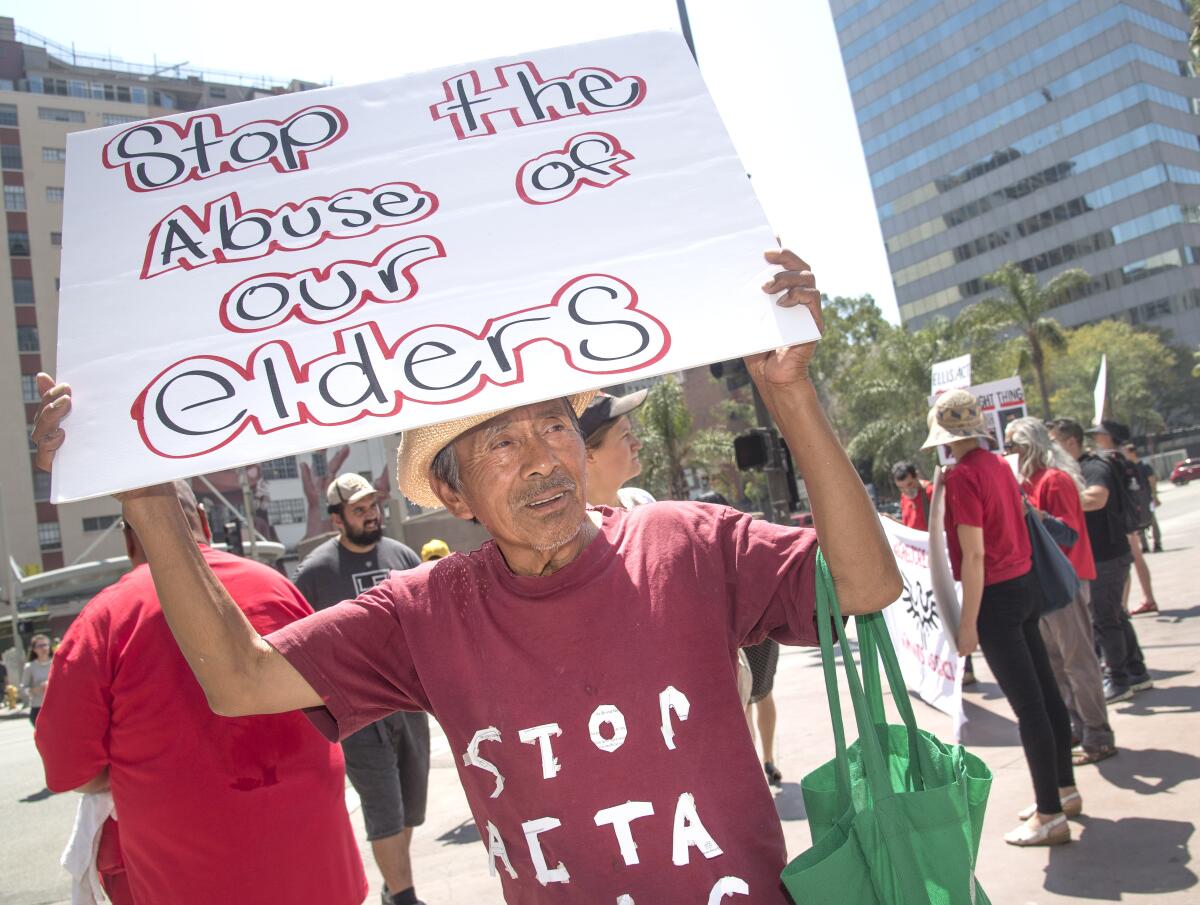Editorial: Don’t let real estate investors destroy all our rent-controlled housing stock

- Share via
Living in California only gets more difficult as rents go up and affordably priced housing becomes more scarce. The problem is particularly acute in pricey urban coastal areas, like Los Angeles, where three out of four households say they spent more than one-third of their income on rent and utilities.
The solution to the housing crisis is to build more housing for all income levels, and California has done a dismal job at that for decades. But that’s only part of the solution. Protecting and preserving the existing affordable housing stock — particularly rent-controlled apartments and homes — is essential to keeping people housed.
Yet tenant advocates warn that California is losing thousands of rent-controlled units to real estate speculators and developers who buy up older buildings, evict the tenants and redevelop the properties, often into expensive new condo or rental units.
Now the Legislature is considering Assembly Bill 854 by Assembly member Alex Lee (D-San Jose) that would put some brakes on how quickly a new owner of a rent-controlled property can turn it into a market rate property. That’s a course correction that could stem the evictions of renters out of rent-controlled units and into a housing market many can’t afford. The Assembly should vote to approve this bill and send it on to the state Senate for further refinement.
A 1985 state law called the Ellis Act allows owners of rent-controlled properties to exit the rental business under certain conditions. It doesn’t matter whether the owner has held the property for decades or a month.
They can take an entire building out of the rental market. They can evict all the tenants, allowing them four to 12 months to move out, and offer them some relocation money (which, say tenant advocates, rarely covers the cost of finding, securing and renting another unit in the same city.) The owner can then leave the building empty, convert the units into for-sale condominiums or demolish the building and construct a new condo or market-rate rental property in its place. (In the city of L.A., if the developer does build market-rate units, there must be a set-aside of a percentage of the units as affordable or all the units must be rent-controlled after the rent is initially set at a market rate.)
AB 854 would require that a landlord own a rent-controlled property for five years before converting it to another use. Tenant organizations say that most Ellis Act evictions are being done by developers who own the property for less than a year.
The purpose is to discourage real estate speculators from targeting rent-controlled properties and help stop the displacement of the tenants who have the least ability to sustain losing an affordable apartment— lower-income, elderly and disabled among them. It would only apply to the 21 jurisdictions in the state that have rent control.
The bill is co-sponsored by the Coalition for Economic Survival in Los Angeles and the Tenderloin Housing Clinic in San Francisco and supported by dozens of tenant, housing, legal and political organizations. Several cities, including Los Angeles, Culver City, Santa Monica and San Francisco, support it.
More than 27,000 rent-controlled units have been taken off the market in the city of Los Angeles alone under the Ellis Act over the last 20 years, according to an analysis by the Assembly Housing and Community Development Committee.
The opponents are mostly property owner groups. Some argue that this law will make it harder for mom-and-pop landlords to sell their property because speculators and developers won’t be as eager to buy if there is a five-year waiting period before they can convert the rental property into something else.
But that doesn’t take into consideration that there are other buyers beside speculators for buildings being sold by mom-and-pop landlords — including landlords and other investors who want to buy and hold rental properties. And it also assumes that an investor or developer wouldn’t consider buying a rent-controlled building that could still be a gold mine at the end of five years.
Legislators have tried before unsuccessfully to put constraints on the Ellis Act. But we are in nothing less than a housing crisis, and that requires new strategies both to create more housing and protect the housing we already have. AB 854 is one way to preserve the dwindling supply of affordable rent-controlled housing that exists.
More to Read
A cure for the common opinion
Get thought-provoking perspectives with our weekly newsletter.
You may occasionally receive promotional content from the Los Angeles Times.










